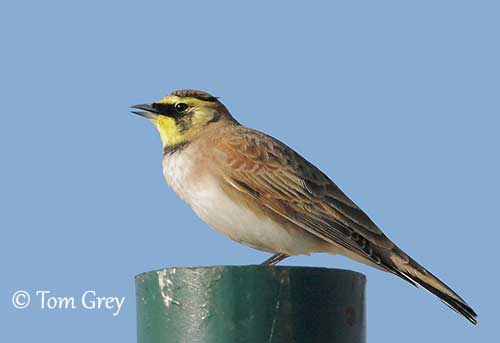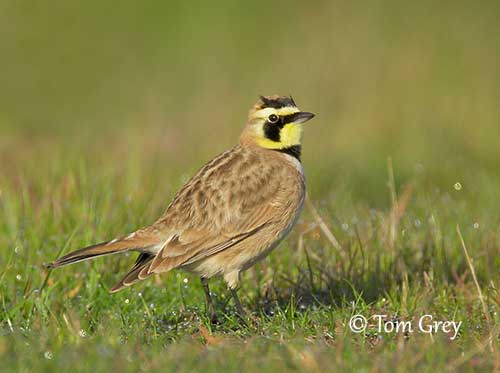
Fr: Alouette hausse-col
Ang: Horned Lark - Shore Lark
All: Ohrenlerche
Esp: Alondra Cornuda
Ita: Allodola golagialla
Nd: Strand leeuwerik
Sd: Berglärka
Photographers:
Aurélien Audevard
OUESSANT DIGISCOPING
Tom Grey
Tom Grey's Bird Pictures & Tom Grey's Bird Pictures 2
Patrick Ingremeau
TAMANDUA
Tom Merigan
Tom Merigan’s Photo Galleries
Bob Moul
Nature Photography
Otto Plantema
Trips around the world
Simon Tan
PBase Bird galleries
Ingo Waschkies
My bird pictures on Pbase
Text by Nicole Bouglouan
Sources:
HANDBOOK OF THE BIRDS OF THE WORLD Vol 9 - by Josep del Hoyo - Andrew Elliot - David Christie - Lynx Edicions - ISBN: 8487334695
THE COMPLETE BOOK OF BRITISH BIRDS – Written by “Royal Society for the Protection of Birds” experts - Préface de Magnus Magnusson - Michael Cady- Rob Hume Editors - ISBN: 0749509112
THE HANDBOOK OF BIRD IDENTIFICATION FOR EUROPE AND THE WESTERN PALEARCTIC by Mark Beaman, Steve Madge - C. Helm - ISBN: 0713639601
BIRDS OF THE MIDDLE EAST by R.F. Porter, S. Christensen, P Schiermacker-Ansen C.Helm - ISBN: 0713670169
FIELD GUIDE TO THE BIRDS OF NORTH AMERICA - National Geographic Society - ISBN: 0792274512
A GUIDE TO THE BIRDS OF MEXICO AND NORTHERN CENTRAL AMERICA by Steve N. G. Howell, Sophie Webb - Oxford University Press - ISBN: 0198540124
A GUIDE TO THE BIRDS OF COLOMBIA by Steven L. Hilty and William L. Brown - Princeton University Press – ISBN 069108372X
All About Birds (Cornell Lab of Ornithology)
Bird Web (Seattle Audubon Society)
What Bird-The ultimate Bird Guide (Mitchell Waite)
Wikipedia, the free encyclopaedia
Life Histories of Familiar North American Birds
Department of Environmental Conservation
Home page
Page Passeriformes Order
Horned Lark
Eremophila alpestris
Passeriformes Order – Alaudidae Family
INTRODUCTION:
The Horned Lark has numerous subspecies (42) throughout its wide range over the northern parts of both New World and Old World. It is the only lark that is native to North America. The Alaudidae are mainly Old World species.
The head pattern is distinctive in all races, with black “horns”, white or yellowish face and throat, broad black stripe from lores, below the eye and down to the cheeks, and conspicuous black breastband.
During winter, large flocks can be seen walking and running in search of seeds, including in the snow. During the breeding season, they become territorial, and we can hear the male’s songs, both in territory defence and during displays.
The Horned Lark is very distinctive with the “horns” raised during the breeding season. The male performs the typical aerial displays of larks, circling high in the air and hovering on fluttering wings while singing.
This species is common and widespread throughout the range, and currently not globally threatened.

DESCRIPTION OF THE BIRD:
Biometrics:
Length: 14-17 cm
Weight: 30-40 g
The Horned Lark of nominate race “alpestris” is a medium-sized lark with long body often held in a horizontal posture.
The male has sandy to rusty-brown upperparts including central crown to upper mantle, rump and uppertail-coverts, with pale pinkish tinge. The rest of the upperparts is greyer with dark streaks. The wings can be slightly darker with pale-edged feathers. The tail is blackish with paler, brownish, central rectrices and white-edged outer feathers.
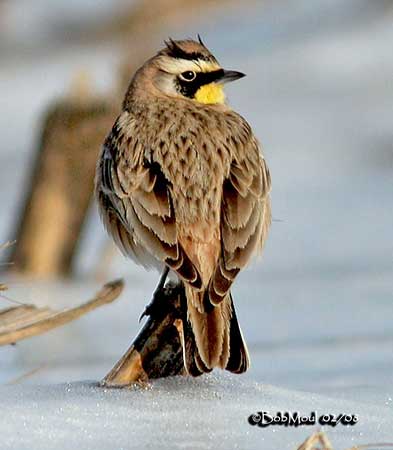
On the underparts, we can see a conspicuous black breast band. Rest of underparts is whitish, with pinkish-rufous wash on breast side to rear flank. The undertail feathers are black, whereas the flight feathers are pale grey.
The head shows distinctive pattern with yellow forehead and supercilium, chin and throat, extending to neck side and to the yellowish ear-coverts. This yellow pattern contrasts strongly with the black central crown and the elongated lateral black tufts (horns), and the black mask extending from lores and below the eye, down to the cheeks.
The bill is greyish-black. The eyes are dark brown. Legs and feet are black.
The non-breeding male has duller head pattern with pale fringes to feathers. The horns are shorter.
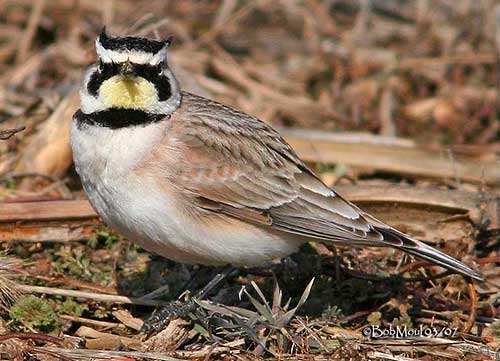
The female is slightly duller than male and smaller too. She has the black bands on the head, but her face is grey instead of white. The breast band is narrower.
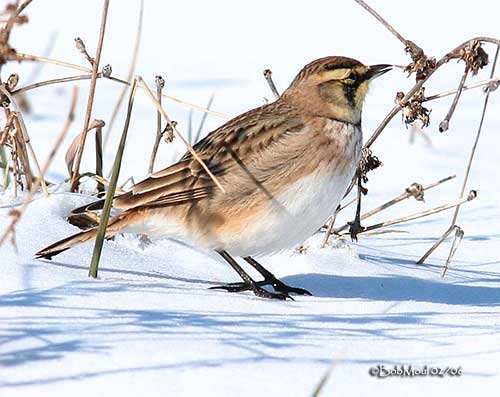
E.a. alpestris
female
The juvenile has heavily spotted black-and-white head and upperparts. Throat and lower neck sides are white, whereas the breast band is mottled. It resembles adult after the autumn moult.
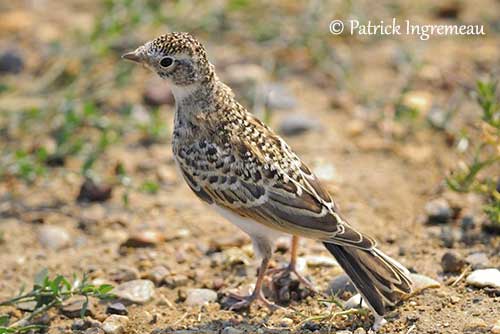
E.a. enthymia
Juvénile
SUBSPECIES AND RANGE:
The Horned Lark has currently 42 recognized subspecies that differ mainly in colour and pattern of male’s plumage. The migratory races are larger, darker and with longer wings than resident subspecies. The birds living in arid habitats tend to be smaller than those of moist areas. The size decreases with the altitude.
The eastern races are usually rather pale, greyish to sandy.
The race E.a. brandti has whitish, not yellow, pale areas on the head.
The race E.a. albigula is paler overall with white, not yellow, pale areas on the head, grey central crown and hindneck, and sandy, finely streaked upperparts.
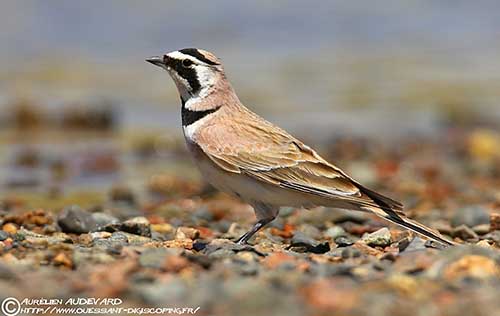
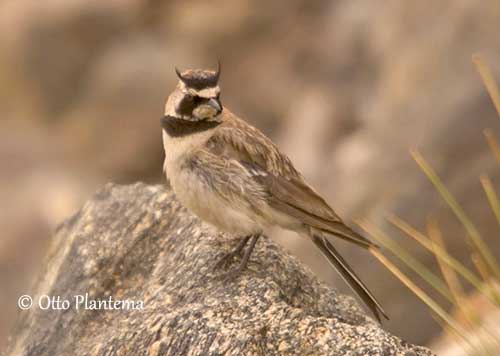
The western races have dark reddish nape to upper mantle and breast sides, bright yellow head and heavily streaked upperparts.
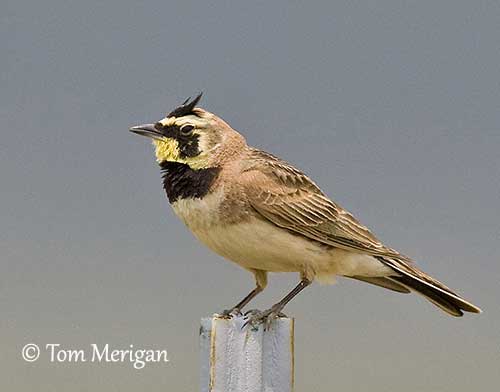
The race E.a. flava from Eurasia resembles nominate with paler (less deep red) lesser coverts.
Further South, the race E.a. atlas is found in Morocco in Atlas Mts.
The race E.a. peregrina is found in E Andes of Colombia. It has whitish forehead and supercilium, yellow throat, greyish nape and dark grey upperparts.
HABITAT:
The Horned Lark is a bird of open ground. It frequents tundra and alpine habitat, usually barren ground with short vegetation.
The Eurasian birds breed above the tree line in mountains and the far North, up to 5400 metres of elevation in Himalaya. During winter, they can be seen on seashore flats, open coast and dunes.
In America, this species can be found on farmland, prairies, deserts, golf courses and airports.
CALLS AND SONGS: SOUNDS BY XENO-CANTO
The Horned Lark sings from perch or in flight. The flight calls are high-pitched, mournful, thin “siit-di-dit”. The alarm call is a high “pseeeee”. Varied other calls include high, sweet “t-sleep”, a buzzy “tzzzip” and a rolled “trri-it”.
The song is rather short and includes sweet, tinkling phrases “tu-a-li, tiali-ti” or similar. It is usually given by a bird perched on rock or in flight.
The song flight is often uttered at great height and while hovering, a typical lark behaviour.
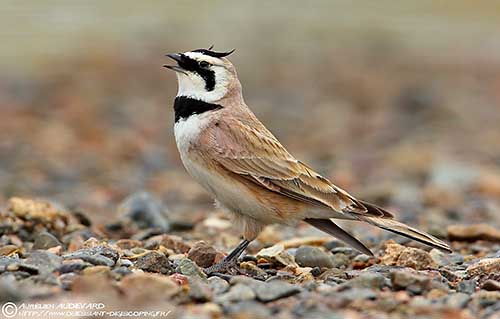
BEHAVIOUR IN THE WILD:
The Horned Lark feeds on a variety of invertebrates during summer, such as grasshoppers, beetles, flies and lepidopteran larvae. During the nesting period, the chicks are fed primarily with invertebrates and earthworms too.
During winter, it feeds mostly on small grass seeds. Like many other birds, it also ingests small stones to facilitate the digestion of these seeds.
The Horned Lark forages on the ground. It can be seen alone or in small to large flocks. They are usually loosely packed, a few metres from each other. They walk and run while pecking or digging, taking seeds from plants or pursuing a prey by running.
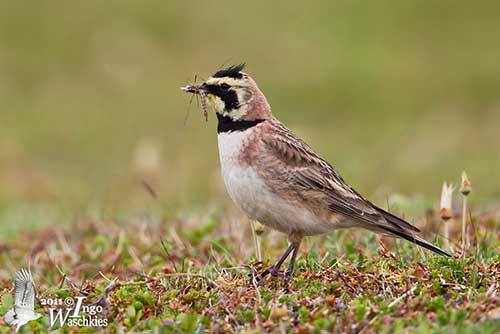
They are gregarious outside the breeding season, but they become territorial during the nesting period. They are monogamous. The establishment of well-defined territories involves fighting between males on the boundaries. The males strut in front of each other and peck strongly the ground. The owner chases the other male back and forth.
The male performs aerial displays and rises at great height, up to 250 metres, hovers and sings, before to drop vertically back to the ground with the wings tightly folded.
Some displays take place on the ground, when the male struts in front of the female with dropped wings, spread tail and raised horns. The same posture is used as intimidation displays towards other male at territory’s boundary.
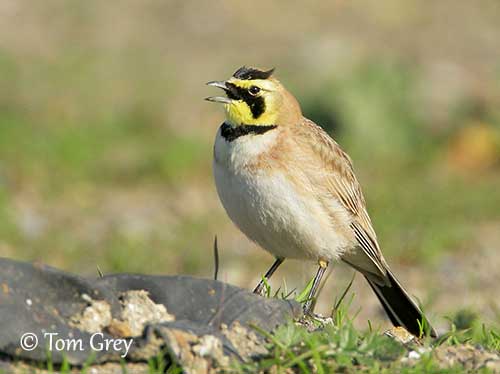
The Horned Lark is migratory or at least partially migratory in the northern parts of the range, whereas in the south, the birds are resident or only perform altitudinal movements.
The northernmost birds leave their breeding grounds in October, and the return migration occurs in late February in S Canada and April/May in Alaska and N Canada. In Eurasia, they return to the breeding grounds from late April in N Norway and from mid-May in extreme N Russia. The males usually arrive before the females. The Horned Larks breeding in Asian mountains reach lower elevations in winter.
They often migrate in flocks of up to 50 birds, although in hard weather conditions, flocks of several hundreds of birds can be seen both during the migration and outside the breeding season.
The Horned Lark usually flies low over the ground with choppy undulations caused by 3-4 rapid wingbeats interspersed with short glides on closed wings. The bird sings on the climb of each undulation. Longer flights are undulating too.
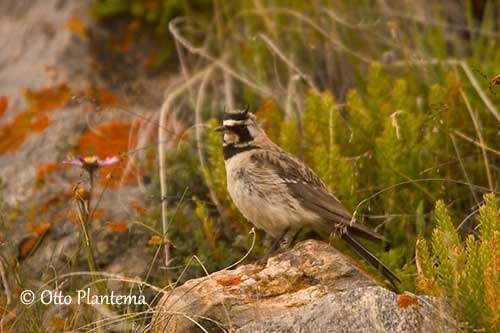
REPRODUCTION OF THIS SECIES:
The breeding season varies depending on the range. The season starts in mid-February in S USA, and from mid-May in Canadian Arctic. In Eurasia, it occurs from late May to mid-July in Scandinavia, but from mid-June in Arctic Russia.
The Horned Lark nests on the ground, usually in sparsely vegetated areas with grasses, but also in prairies, coastal dunes, sandy beaches, grasslands, estuaries, agricultural fields, wetlands and airports.
The female alone builds the nest in excavated cavity or natural depression on the ground. She uses woven plant materials and the inner part is lined with softer materials and feathers. Other materials such as stones, bark or animal dung are placed around the nest that is protected by some vegetation from wind and sun.
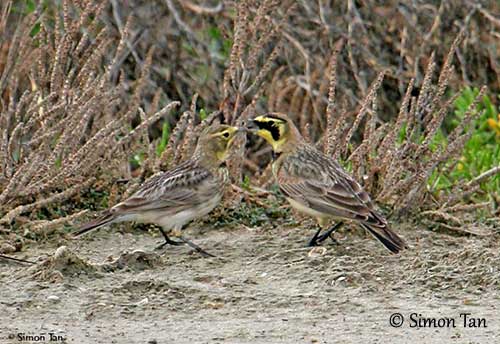
The female lays 2-5 pale grey to greenish eggs with fine brown markings. She incubates alone during 11-12 days. The chicks are fed by both parents. They leave the nest 9-12 days after hatching, and they are able to fly at 16-18 days old. They reach the adult size at about one month.
The breeding success depends on weather conditions, but the Horned Lark’s nests are sometimes parasitized by the Brown-headed Cowbird in North America.
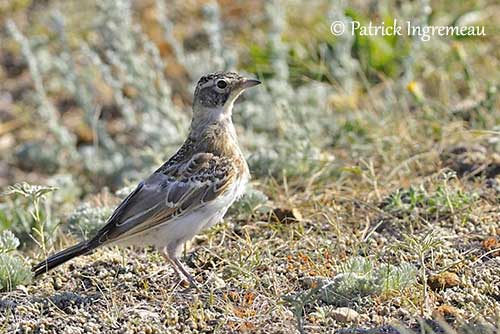
E.a. enthymia
Juvénile
PROTECTION / THREATS / STATUS:
The Horned Lark has very wide range in which this species is common, and even locally very common, although it can be scarce in some areas.
However, the Horned Lark is threatened by habitat loss for agriculture and industry expansion, invasive plant species on coastal areas, and incompatible management practices. Disturbances on some nesting areas affect the breeding success.
The global population was estimated to number 140,000,000 individuals (2004). Some small decrease is reported in North America.
But currently, the Horned Lark is evaluated as Least Concern.
